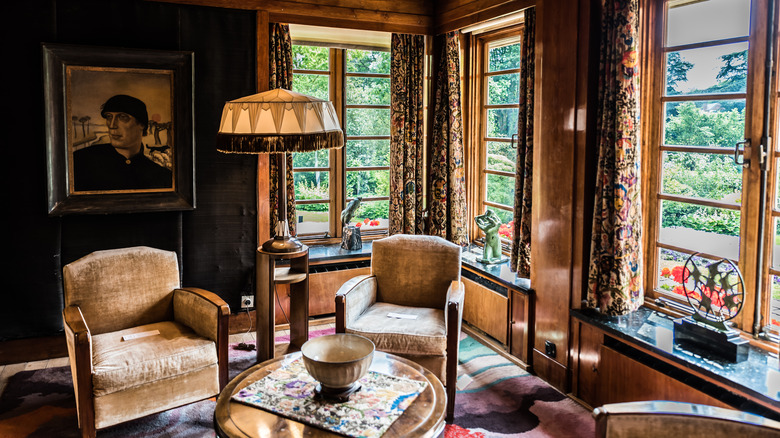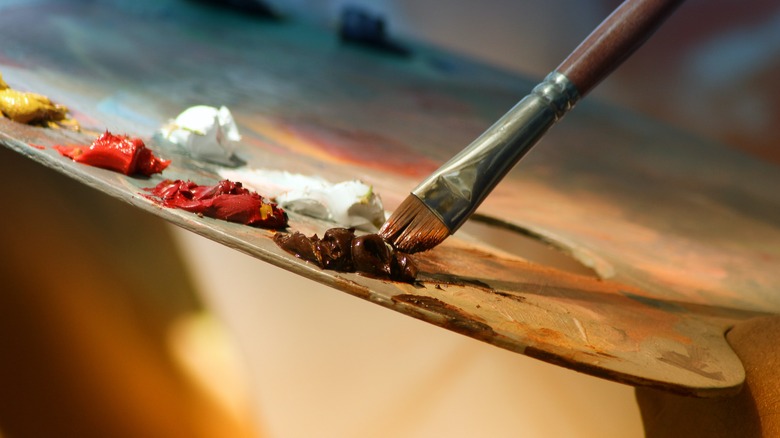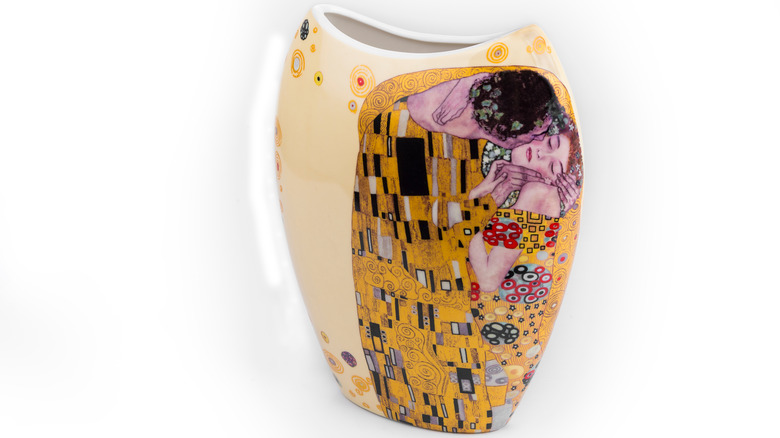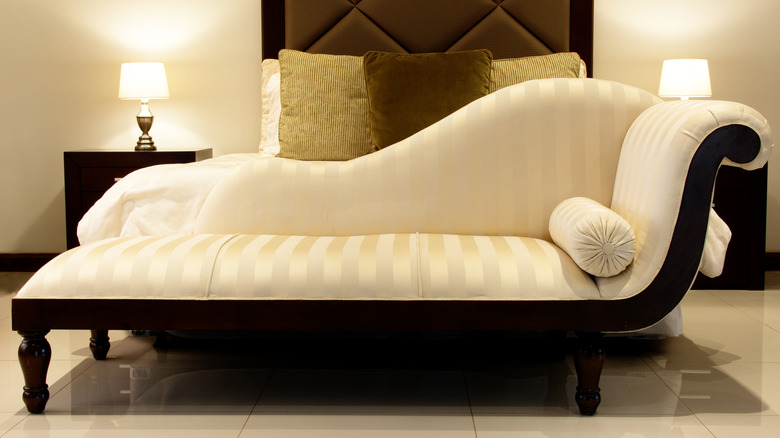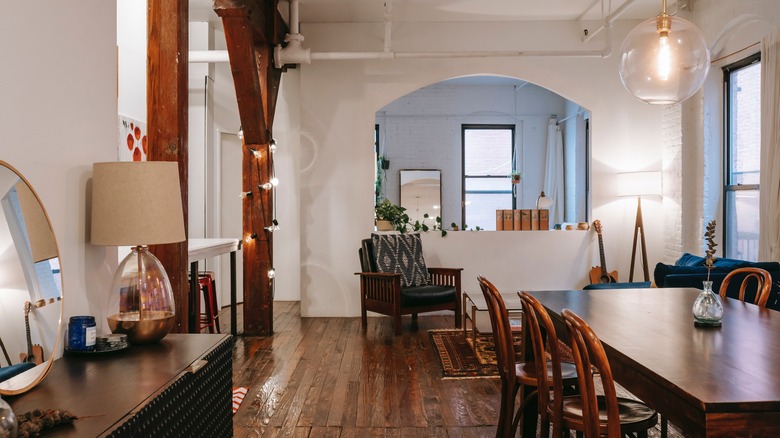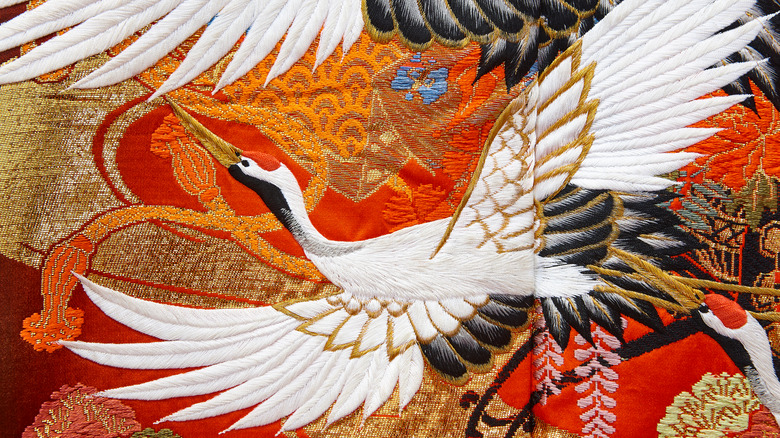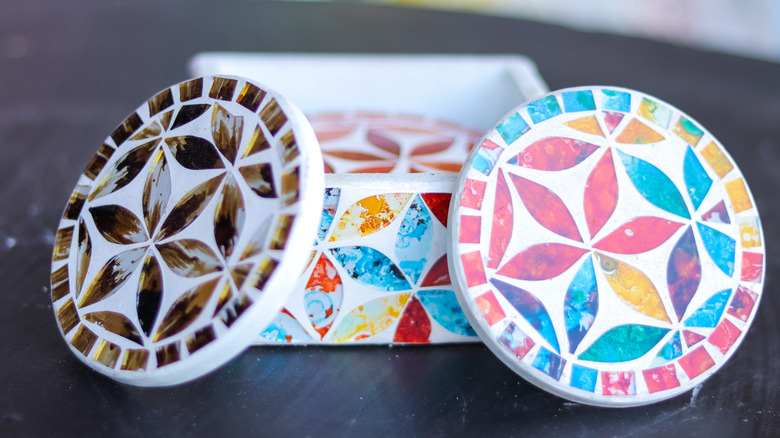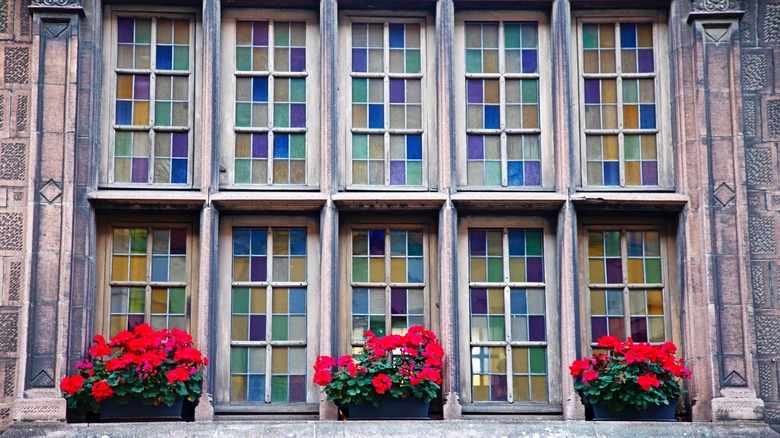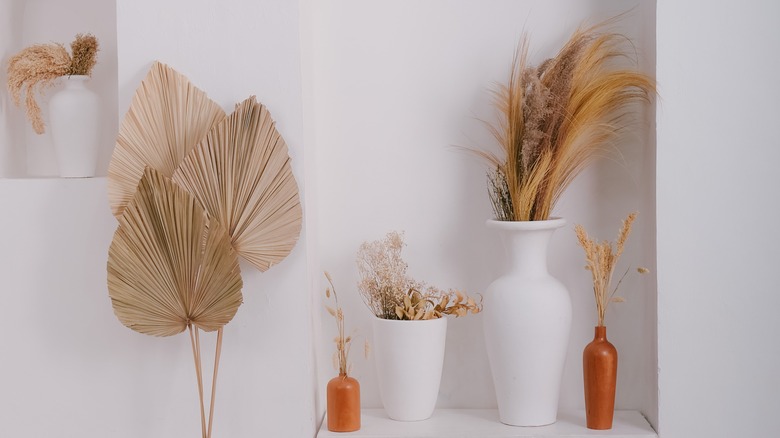The Ultimate Guide To Art Nouveau Decor
You've probably heard of Post Modernism and art deco, but are you familiar with art nouveau? French for new art, this ornamental style became popular in paintings and art, but also found its way into design and architecture between 1890 and 1910, according to Britannica. The unique style also came back around in the 1960s, and has since shown up in decor around the world. This new movement of art, which veered away from historicism and towards more organic lines, was an intentional shift away from the old. The elements and trends of the movement gained popularity throughout Europe in places like Germany, France, and Belgium, as well as in the United States of America. At the time, artists and people sought to break away from traditional styles and connect with nature and freedom. That is how elements, such as organic lines, florals, and arches, gained momentum (via The Metropolitan Museum of Art).
Art nouveau is often achieved through a mixture of materials and honed in on the idea that art could be everywhere. For example, functional architectural elements were suddenly doubled as art, and simple items and tools were transformed into masterpieces. This sharply contrasted previous styles and designs that focused on concise structure and functionality. Beams and poles were suddenly a perfect opportunity to incorporate florals, vines, and other natural elements. Arches were structurally sound, but they also became a way to soften designs and add whimsy. Art nouveau is full of features that reflect these ideals. The original artists were attracted to the idea of surrounding themselves with beauty and natural things, which is why it is still frequently used in interior design, as well as art, jewelry, fashion, and architecture.
Where did art nouveau originate?
Initially coined by the Belgian journal "L'Art Moderne," the new art movement was closely related to post-impressionism and Symbolism, according to The Metropolitan Museum of Art. Later, the elements and concepts greatly influenced art deco styles and principles; however, the initial movement was somewhat brief. The style was sparked by those who wanted to push against the standard — that's why it also became popular in the 1960s when political unrest and uncertainty existed. Art was and is a form of expression, and art nouveau was greatly influenced by emotions and the urge to break away from what was viewed as conventional. This type of art seems to be a natural shift when people feel uninspired or too structured.
The style was adopted by influential artists worldwide and quickly became well-known by their fans and many others. The Belgian artist group known as Les Vingt was an early participant in the movement and appreciated the progressive nature of the style (via the Encyclopedia of Art History). A few years later, Siegfried Bing opened a gallery dedicated to the up-and-coming style. In another few years, art nouveau gained more attention at an art fair that occurred every 11 years, known as Exposition Universelle. Although the art form originated a long time ago and tends to fade in and out of popularity, it consistently comes back around because of its well-known elements. There's a sense of positivity embedded in the style, and the art is often uplifting and peaceful, making it a style bound to last.
Art nouveau paintings are conversation starters
One simple way to incorporate art nouveau into your personal space and interior design is to focus on the art nouveau paintings and sculptures that initially brought awareness to the movement. Paintings and sculptures are a simple way to upgrade your decor and lean into a particular style. Whether these paintings are framed and hung on the wall or depicted on throw pillows, coasters, and vases, they are the ultimate way to add art nouveau to your decor.
"The Kiss" by Gustav Klimt is perhaps one of the most well-known paintings around the world, and it's definitely one of the most prominent art nouveau paintings, according to The Dolphin Gallery. The painting is full of light colors, florals, emotion, and long swooping lines that were made popular during the movement. The image clearly depicts a passionate couple with lots of organic, curved lines and ambiguous details, which are common in this style. This painting, along with other popular pieces of the time, highlights the natural world, florals, and mosaics, which directly reacted to the strict symmetrical and rigid features of prior art (via Art In Context).
Other popular paintings include "At the Moulin Rouge" by Henri de Toulouse-Lautrec and "Les Femmes Fatales" by Gerda Wegener. A large framed picture or a small depiction on a coaster can set you on the right path regarding your decor. Any sculpture or piece of art from the movement will give you a jumping-off point and inspire you while decorating.
Incorporate asymmetrical shapes
Asymmetrical shapes and lines are one of the art movement's elements that seem to shine through and set off the differences in other styles. According to DK Studio, the concept of asymmetrical shapes is meant to depict natural movement, which is all tied to the natural elements that inspired these artists. Florals in various stages of life, vines, grasses, insects, animals, wind, and water are brought to life with elegant and unrestricted asymmetrical shapes and lines that seem to move on the page.
The artists wanted to turn away from machine-made things, straight lines, right angles, and uniform patterns. This contrast from what used to be was the appeal of the new art movement. According to Britannica, the idea of lines and shapes that didn't perfectly line up or correspond was accomplished in paintings and sculptures, but also architecture and graphic arts. Consider an oblong mirror or one that is framed by curved lines for your decor. Gallery walls of various-sized frames or mismatched styles are a great way to break away from symmetry in your decor. Additionally, unique bookshelves, curved sofas, contrasting textures, and other free-form furniture that are not uniform or perfectly symmetrical can add that organic, lively feel that art nouveau is known for.
Arches and curves for the win
The art nouveau movement was overflowing with curves and dancing lines, including many arches in architecture, paintings, rugs, and more. The curves were applied wherever they could be, and several elements can still be found in modern art and design today, according to Doris Leslie Blau.
Arches are for so much more than aqueducts and gothic churches. The rounded structures are known for their strength and support, which is why they can be found in architecture throughout the world. However, they also add a touch of elegance and remain a large part of modern designs in large and small forms.
Arches can add contrast to your space, and their organic nod toward nature can create a calm, peaceful atmosphere. This detail can be incorporated into several areas of your home. Designers add arches to doorways and between ceiling beams to create natural lines. Arches have also become popular at the top of floor-to-ceiling bookshelves to add a finishing touch. Other ways to include arches are arched mirrors, chairs with arched backs, rounded headboards, benches that have arches underneath, fireplaces with rounded tops, and even arched picture frames. These curved lines really pop in a space when they create a contrast between right angles and straight lines. The softer lines pair nicely and bring them into focus. Rounded lighting fixtures, rounded tiles, windows, and chairs are excellent additions to your modern decor that fit the art nouveau style.
Japanese motifs
Artists during the art nouveau movement also drew inspiration from several Japanese motifs that embraced the idea of nature in intricate but soft details, according to EmptyEasel. Woodblock art, traditional patterns, classic depictions of animals, nature, and florals are symbolic in Japanese culture and tied in perfectly with the new art movement, which is why they are so prevalent.
Woodblock art is a form of art that is similar to what we understand as stamping today. This art form involved carving an image or a whole scene into a block of wood and then layering ink or paint on top of it before stamping it onto paper, according to Coloray Decor. Extremely detailed scenes of wildlife, nature, beautiful women, and more were tediously carved into wood and painted with intricate colors to create woodblock art. These brightly-colored works of art were common in art nouveau and are still recognizable in modern interior design today.
The patterns found in Japanese clothing, fabrics, and art are meaningful symbols in its culture that have a long history, according to Japan Avenue. These intricate patterns with bright colors and lively scenes were often incorporated into the new art designs. Well-known Japanese patterns depicting repeating geometric shapes were designed to replicate specific patterns found in animal fur, native plants, and bird wings. Floral prints were common and represented different meanings, such as love, virtue, and passion, all of which can be translated by Hanakotoba, the language of flowers. Patterns depicting animals and landscapes often represented local legends and myths in Japanese culture.
Mosaics can be modern and lovely
Mosaics were another common element of the art nouveau movement. They were often messy and expressed emotion and passion in an unstructured way compared to tiles with straight lines and right angles, according to Mission Tile West. Mosaics are made up of brightly colored tiles and shards that were often misshapen and in various sizes that overlapped or bumped into each other. Even paintings, such as "The Kiss" by Gustav Klimt, show how artists incorporated the concept into many art forms. The idea went nicely with the organic, natural themes in art nouveau.
Mosaics give the distinct feeling of a story being told, not only about the scene depicted, but about the artist who took the time to puzzle together each piece. Mosaics in your decor can be more than wall art — they can be added to several other spaces and surfaces around your home. Consider a mosaic backsplash in your kitchen or bathroom. Whether handmade or stick-on, the appearance of bright colors and tiny pieces can be a nice contrast to your modern, sleek kitchen. This is also an opportunity to add color and creativity to your decor that is a little unexpected. Mosaic flooring will upgrade your space and draw the eye, creating a very finished, thoughtful design that you know took time and attention to execute. Other places to include mosaics are pool tiles at the bottom or around them, on top of tables and shelves, and around mirrors, clocks, and pictures. Mosaic coasters and coffee tables have also become quite common.
Stained glass
Stained glass was popular in the art nouveau moment for reasons similar to the mosaics. The intricate details, imperfect pieces, and shards felt natural and organic, according to DK Studio. Stained glass came onto the art scene in 1879 when John LaFarge invented it. It quickly gained attention for the way light beautifully shimmered through the pieces and patterns (via Buffalo as an Architectural Museum. The art nouveau artists were drawn to the organic feel of stained glass and added it to their art in whatever way they could. It wasn't always about glass but could be painted or sculpted too.
In modern interior design, stained glass windows have become much more attainable and familiar, even in homes and offices around the world. According to Coveteur, stained glass is a way to balance the modern with the classic. For example, in a classic home in New Jersey, stained glass windows at the top of floor-to-ceiling windows helped achieve a light, airy space that connected the space with the natural elements outside and the house's history.
The enviable designs of stained glass were once reserved for churches and castles; however, it is a much more attainable decor element today. Static cling window shades can give windows the appearance of stained glass without the cost and hassle. Even rainbow or tinted windows and doors inside the house can be simple to create with window and glass films (via Lovely Indeed). Glass that brightens in the natural light can be a simple and elegant way to incorporate art nouveau into your decor.
Natural elements
The fixation with natural elements in art nouveau was the result of a world that was quickly becoming dominated by machines and mass production, according to DK Studio. However, the art was about more than images of wildlife and nature. It highlighted the life of nature and relied on realism from naturalist illustrations to depict the vibrant natural world, according to Europeana.
Florals and other plants were featured alongside sunlight and natural inhabitants in a realistic way. Pictures of animals were often detailed in natural colors and tones that were true to how they existed in real life. Butterflies, dragonflies, peacocks, and other birds with sweeping wingspans and intricate details were often painted on vases, embellished on cups, mugs, and onto jewelry, hair combs, brushes, and mirrors during this time. Art nouveau was about bringing art and beauty into everyday life and everyday surfaces. Natural elements appealed to the masses and were added to everything.
Vases double as art
Everything about vases — from the shape of the design to the colors to the materials — can bring a little art nouveau into your space, according to Musical Expert. They are also a simple, often inexpensive way to upgrade your home decor. The shapes that are associated with art nouveau are tall vases with rounded, sloping sides and wide, flared openings. Stay away from short, squat vases that are square or rectangular; they do not reflect the curved lines from the movement. Vases that are textured and embellished with vines, flowers, and other leaves are also on-theme.
The colors of the new art movement were not as intense or dark as in previous eras. Popular colors were lighter, crisper, and more natural, such as greens and blues, along with peach and other natural tones. Vases also make it easy to add florals, vegetation, and other natural elements such as branches, stalks, and even feathers to your space.
According to A Blissful Nest, there are a few tips for decorating with vases. Stacking the vases on top of books and small shelves can add a layered effect to your decor. A single vase works better with a larger bouquet of flowers, but vases that are clustered together are better for displaying various styles of vases and just a few branches or stalks. Adding multiple vases around a room that are the same color or style can help tie the room together and create a cohesive look. Consider a set of vases for your living room or office. You can experiment with keeping them together or spacing them out. Don't be afraid to mix and match designs and sizes to really highlight the sense of art nouveau. Taryn Whitaker also explains that vases near your entryway create a welcoming, peaceful atmosphere for those entering your home. Even just a few of these elements and design ideas can transform your office, bedroom, living room, and more into a recognizable art nouveau oasis. Happy decorating!
